Input interpretation

HgO mercuric oxide ⟶ Hg mercury + O_3 ozone
Balanced equation
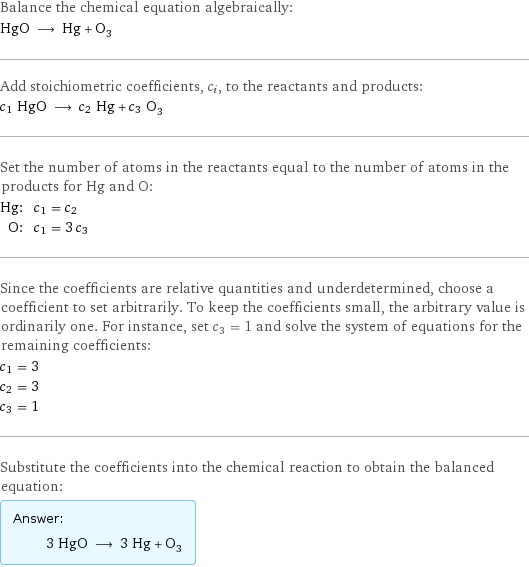
Balance the chemical equation algebraically: HgO ⟶ Hg + O_3 Add stoichiometric coefficients, c_i, to the reactants and products: c_1 HgO ⟶ c_2 Hg + c_3 O_3 Set the number of atoms in the reactants equal to the number of atoms in the products for Hg and O: Hg: | c_1 = c_2 O: | c_1 = 3 c_3 Since the coefficients are relative quantities and underdetermined, choose a coefficient to set arbitrarily. To keep the coefficients small, the arbitrary value is ordinarily one. For instance, set c_3 = 1 and solve the system of equations for the remaining coefficients: c_1 = 3 c_2 = 3 c_3 = 1 Substitute the coefficients into the chemical reaction to obtain the balanced equation: Answer: | | 3 HgO ⟶ 3 Hg + O_3
Structures

⟶ +
Names

mercuric oxide ⟶ mercury + ozone
Reaction thermodynamics
Enthalpy
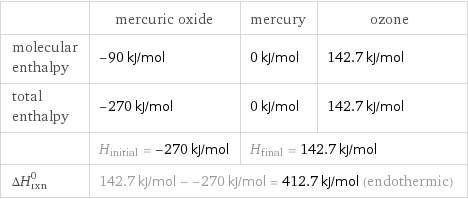
| mercuric oxide | mercury | ozone molecular enthalpy | -90 kJ/mol | 0 kJ/mol | 142.7 kJ/mol total enthalpy | -270 kJ/mol | 0 kJ/mol | 142.7 kJ/mol | H_initial = -270 kJ/mol | H_final = 142.7 kJ/mol | ΔH_rxn^0 | 142.7 kJ/mol - -270 kJ/mol = 412.7 kJ/mol (endothermic) | |
Gibbs free energy
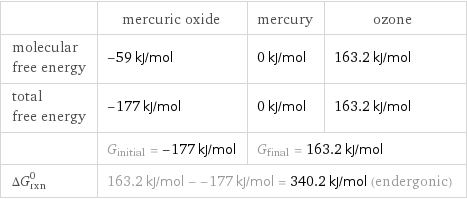
| mercuric oxide | mercury | ozone molecular free energy | -59 kJ/mol | 0 kJ/mol | 163.2 kJ/mol total free energy | -177 kJ/mol | 0 kJ/mol | 163.2 kJ/mol | G_initial = -177 kJ/mol | G_final = 163.2 kJ/mol | ΔG_rxn^0 | 163.2 kJ/mol - -177 kJ/mol = 340.2 kJ/mol (endergonic) | |
Entropy
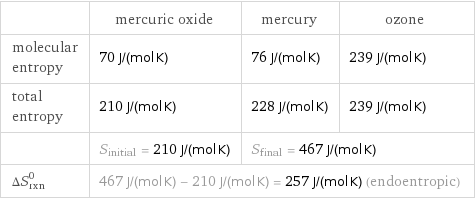
| mercuric oxide | mercury | ozone molecular entropy | 70 J/(mol K) | 76 J/(mol K) | 239 J/(mol K) total entropy | 210 J/(mol K) | 228 J/(mol K) | 239 J/(mol K) | S_initial = 210 J/(mol K) | S_final = 467 J/(mol K) | ΔS_rxn^0 | 467 J/(mol K) - 210 J/(mol K) = 257 J/(mol K) (endoentropic) | |
Equilibrium constant
![Construct the equilibrium constant, K, expression for: HgO ⟶ Hg + O_3 Plan: • Balance the chemical equation. • Determine the stoichiometric numbers. • Assemble the activity expression for each chemical species. • Use the activity expressions to build the equilibrium constant expression. Write the balanced chemical equation: 3 HgO ⟶ 3 Hg + O_3 Assign stoichiometric numbers, ν_i, using the stoichiometric coefficients, c_i, from the balanced chemical equation in the following manner: ν_i = -c_i for reactants and ν_i = c_i for products: chemical species | c_i | ν_i HgO | 3 | -3 Hg | 3 | 3 O_3 | 1 | 1 Assemble the activity expressions accounting for the state of matter and ν_i: chemical species | c_i | ν_i | activity expression HgO | 3 | -3 | ([HgO])^(-3) Hg | 3 | 3 | ([Hg])^3 O_3 | 1 | 1 | [O3] The equilibrium constant symbol in the concentration basis is: K_c Mulitply the activity expressions to arrive at the K_c expression: Answer: | | K_c = ([HgO])^(-3) ([Hg])^3 [O3] = (([Hg])^3 [O3])/([HgO])^3](../image_source/d290125dad744d4b1ae9813790d8096b.png)
Construct the equilibrium constant, K, expression for: HgO ⟶ Hg + O_3 Plan: • Balance the chemical equation. • Determine the stoichiometric numbers. • Assemble the activity expression for each chemical species. • Use the activity expressions to build the equilibrium constant expression. Write the balanced chemical equation: 3 HgO ⟶ 3 Hg + O_3 Assign stoichiometric numbers, ν_i, using the stoichiometric coefficients, c_i, from the balanced chemical equation in the following manner: ν_i = -c_i for reactants and ν_i = c_i for products: chemical species | c_i | ν_i HgO | 3 | -3 Hg | 3 | 3 O_3 | 1 | 1 Assemble the activity expressions accounting for the state of matter and ν_i: chemical species | c_i | ν_i | activity expression HgO | 3 | -3 | ([HgO])^(-3) Hg | 3 | 3 | ([Hg])^3 O_3 | 1 | 1 | [O3] The equilibrium constant symbol in the concentration basis is: K_c Mulitply the activity expressions to arrive at the K_c expression: Answer: | | K_c = ([HgO])^(-3) ([Hg])^3 [O3] = (([Hg])^3 [O3])/([HgO])^3
Rate of reaction
![Construct the rate of reaction expression for: HgO ⟶ Hg + O_3 Plan: • Balance the chemical equation. • Determine the stoichiometric numbers. • Assemble the rate term for each chemical species. • Write the rate of reaction expression. Write the balanced chemical equation: 3 HgO ⟶ 3 Hg + O_3 Assign stoichiometric numbers, ν_i, using the stoichiometric coefficients, c_i, from the balanced chemical equation in the following manner: ν_i = -c_i for reactants and ν_i = c_i for products: chemical species | c_i | ν_i HgO | 3 | -3 Hg | 3 | 3 O_3 | 1 | 1 The rate term for each chemical species, B_i, is 1/ν_i(Δ[B_i])/(Δt) where [B_i] is the amount concentration and t is time: chemical species | c_i | ν_i | rate term HgO | 3 | -3 | -1/3 (Δ[HgO])/(Δt) Hg | 3 | 3 | 1/3 (Δ[Hg])/(Δt) O_3 | 1 | 1 | (Δ[O3])/(Δt) (for infinitesimal rate of change, replace Δ with d) Set the rate terms equal to each other to arrive at the rate expression: Answer: | | rate = -1/3 (Δ[HgO])/(Δt) = 1/3 (Δ[Hg])/(Δt) = (Δ[O3])/(Δt) (assuming constant volume and no accumulation of intermediates or side products)](../image_source/70cd1070afb666034cca849e0433ceae.png)
Construct the rate of reaction expression for: HgO ⟶ Hg + O_3 Plan: • Balance the chemical equation. • Determine the stoichiometric numbers. • Assemble the rate term for each chemical species. • Write the rate of reaction expression. Write the balanced chemical equation: 3 HgO ⟶ 3 Hg + O_3 Assign stoichiometric numbers, ν_i, using the stoichiometric coefficients, c_i, from the balanced chemical equation in the following manner: ν_i = -c_i for reactants and ν_i = c_i for products: chemical species | c_i | ν_i HgO | 3 | -3 Hg | 3 | 3 O_3 | 1 | 1 The rate term for each chemical species, B_i, is 1/ν_i(Δ[B_i])/(Δt) where [B_i] is the amount concentration and t is time: chemical species | c_i | ν_i | rate term HgO | 3 | -3 | -1/3 (Δ[HgO])/(Δt) Hg | 3 | 3 | 1/3 (Δ[Hg])/(Δt) O_3 | 1 | 1 | (Δ[O3])/(Δt) (for infinitesimal rate of change, replace Δ with d) Set the rate terms equal to each other to arrive at the rate expression: Answer: | | rate = -1/3 (Δ[HgO])/(Δt) = 1/3 (Δ[Hg])/(Δt) = (Δ[O3])/(Δt) (assuming constant volume and no accumulation of intermediates or side products)
Chemical names and formulas
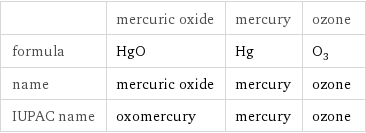
| mercuric oxide | mercury | ozone formula | HgO | Hg | O_3 name | mercuric oxide | mercury | ozone IUPAC name | oxomercury | mercury | ozone
Substance properties
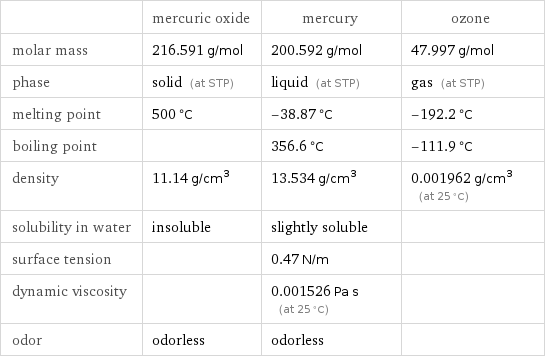
| mercuric oxide | mercury | ozone molar mass | 216.591 g/mol | 200.592 g/mol | 47.997 g/mol phase | solid (at STP) | liquid (at STP) | gas (at STP) melting point | 500 °C | -38.87 °C | -192.2 °C boiling point | | 356.6 °C | -111.9 °C density | 11.14 g/cm^3 | 13.534 g/cm^3 | 0.001962 g/cm^3 (at 25 °C) solubility in water | insoluble | slightly soluble | surface tension | | 0.47 N/m | dynamic viscosity | | 0.001526 Pa s (at 25 °C) | odor | odorless | odorless |
Units
